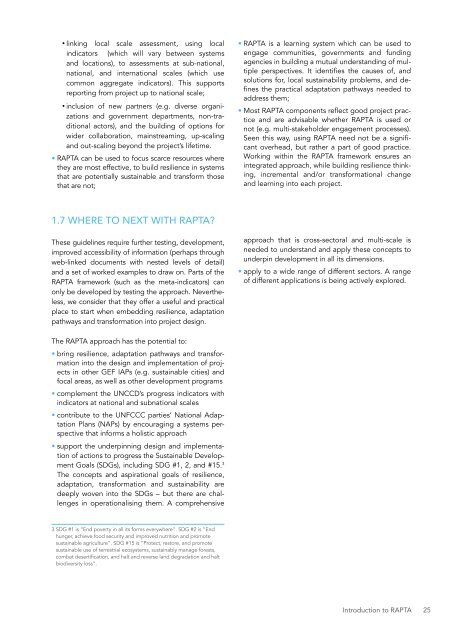DESIGNING PROJECTS IN A RAPIDLY CHANGING WORLD
srun3013fp1
srun3013fp1
You also want an ePaper? Increase the reach of your titles
YUMPU automatically turns print PDFs into web optimized ePapers that Google loves.
• linking local scale assessment, using local<br />
indicators (which will vary between systems<br />
and locations), to assessments at sub-national,<br />
national, and international scales (which use<br />
common aggregate indicators). This supports<br />
reporting from project up to national scale;<br />
• inclusion of new partners (e.g. diverse organizations<br />
and government departments, non-traditional<br />
actors), and the building of options for<br />
wider collaboration, mainstreaming, up-scaling<br />
and out-scaling beyond the project’s lifetime.<br />
• RAPTA can be used to focus scarce resources where<br />
they are most effective, to build resilience in systems<br />
that are potentially sustainable and transform those<br />
that are not;<br />
• RAPTA is a learning system which can be used to<br />
engage communities, governments and funding<br />
agencies in building a mutual understanding of multiple<br />
perspectives. It identifies the causes of, and<br />
solutions for, local sustainability problems, and defines<br />
the practical adaptation pathways needed to<br />
address them;<br />
• Most RAPTA components reflect good project practice<br />
and are advisable whether RAPTA is used or<br />
not (e.g. multi-stakeholder engagement processes).<br />
Seen this way, using RAPTA need not be a significant<br />
overhead, but rather a part of good practice.<br />
Working within the RAPTA framework ensures an<br />
integrated approach, while building resilience thinking,<br />
incremental and/or transformational change<br />
and learning into each project.<br />
1.7 WHERE TO NEXT WITH RAPTA?<br />
These guidelines require further testing, development,<br />
improved accessibility of information (perhaps through<br />
web-linked documents with nested levels of detail)<br />
and a set of worked examples to draw on. Parts of the<br />
RAPTA framework (such as the meta-indicators) can<br />
only be developed by testing the approach. Nevertheless,<br />
we consider that they offer a useful and practical<br />
place to start when embedding resilience, adaptation<br />
pathways and transformation into project design.<br />
approach that is cross-sectoral and multi-scale is<br />
needed to understand and apply these concepts to<br />
underpin development in all its dimensions.<br />
• apply to a wide range of different sectors. A range<br />
of different applications is being actively explored.<br />
The RAPTA approach has the potential to:<br />
• bring resilience, adaptation pathways and transformation<br />
into the design and implementation of projects<br />
in other GEF IAPs (e.g. sustainable cities) and<br />
focal areas, as well as other development programs<br />
• complement the UNCCD’s progress indicators with<br />
indicators at national and subnational scales<br />
• contribute to the UNFCCC parties’ National Adaptation<br />
Plans (NAPs) by encouraging a systems perspective<br />
that informs a holistic approach<br />
• support the underpinning design and implementation<br />
of actions to progress the Sustainable Development<br />
Goals (SDGs), including SDG #1, 2, and #15. 3<br />
The concepts and aspirational goals of resilience,<br />
adaptation, transformation and sustainability are<br />
deeply woven into the SDGs – but there are challenges<br />
in operationalising them. A comprehensive<br />
3 SDG #1 is “End poverty in all its forms everywhere”. SDG #2 is “End<br />
hunger, achieve food security and improved nutrition and promote<br />
sustainable agriculture”. SDG #15 is “Protect, restore, and promote<br />
sustainable use of terrestrial ecosystems, sustainably manage forests,<br />
combat desertification, and halt and reverse land degradation and halt<br />
biodiversity loss”.<br />
Introduction to RAPTA 25


